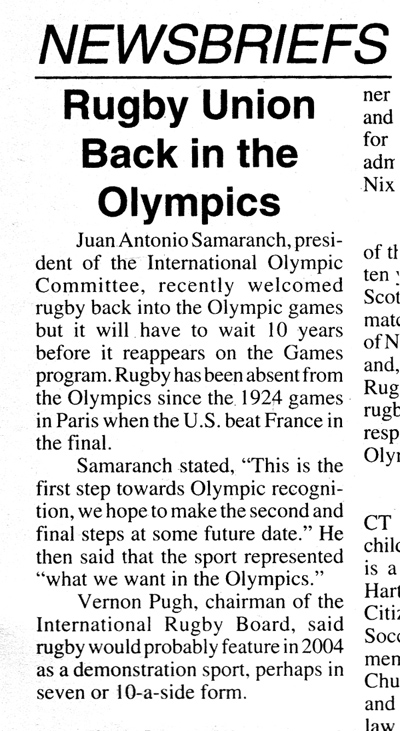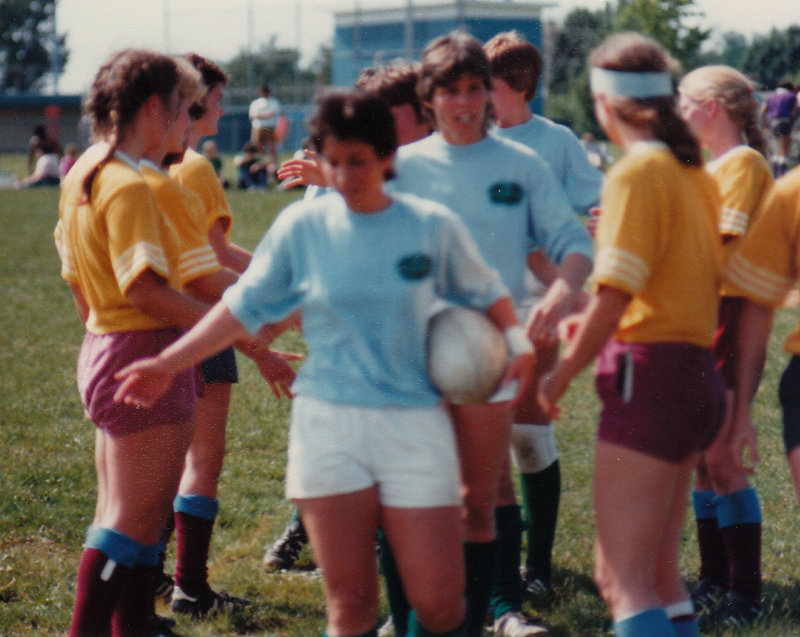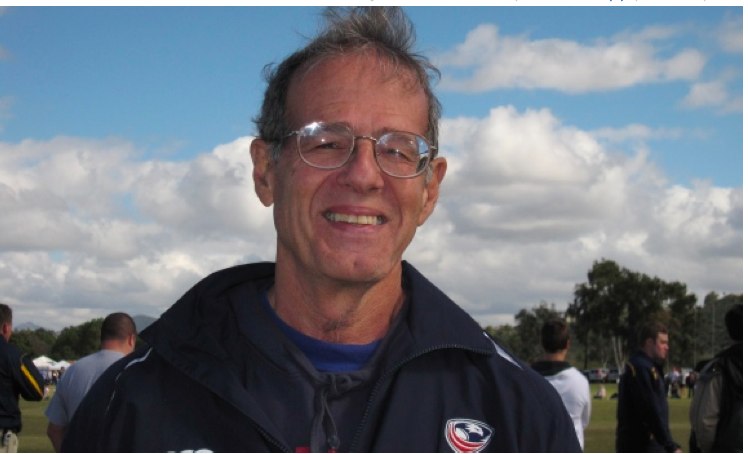
Picture of me from Goff article
Alex Goff published a Rugby Magazine article back in October 2009, "Why Should we Thank This Man for Rugby Getting in the Olympics," in which he stated “Rugby would not be an Olympic sport without the women, and women would not have an international 7s presence were it not for one man – Emil Signes.”
I’m
honored and humbled by that statement and don’t know if it’s
true, but I would like to at least document, as much as I can,
everything I said to Alex that was reprinted in the article. And
more. Document where I can, that is; some of these
comments are based only on my notes at the time they happened.
Sadly, Alex's article is no longer "up" anywhere on the web; I
have, however, saved it on my computer, and the text is included
below.
The entire topic of rugby and the Olympics is
obviously bigger than one person. From what I've done,
heard and read, however, the steps that were taken in the
development of women's sevens in the USA in the 1980s and in
the initiation of international women's sevens in the 1990s,
were at least partly based on my efforts, and it's nice to
watch it all develop.
by Alex Goff

Picture of me from Goff article
Alex's article
follows in red (with my quotes in italics); my documentation
and/or comments are inserted in green (or is it blue? :)
In 2005 the IRB was chastened.
Rugby did not receive what many felt was an automatic “Yes”
vote to put the sport into the Olympics. What had happened.
IRB CEO Mike Miller spelled
out the facts a few months later in a small press conference
at the 2006 USA 7s. Rugby had not embraced the spirit of
Olympism to the right degree. But most of all, rugby had
ignored the women.
Did they have a 7s World
Cup for women? No. Did they even mention women in their
promotional materials? Not really. Miller and the IRB knew
what they had to do. They had to get serious about women's
international 7s. [I hadn't realized
that the IRB really cared; I'm glad they did. Even if it was
only because that's what they needed
to do to get on the IOC's Olympic sport radar.]
Now that rugby has been
accepted into the Olympic Games, it’s fair to say that the
IRB’s success is in part due to their support of the women’s
game. Rugby would not be an Olympic sport without the women,
and women would not have an international 7s presence were it
not for one man – Emil Signes.
Signes pushed for years to
get an international women's 7s circuit and a 7s World
Cup. It took longer than he hoped, but he was clearly proud to
see the event take place in 2009. Not only take place, but be
held alongside with the men.
Here (Signes's own words in
italics) is how it all happened:
On May 15, 1996, the US received an invitation to the
1997 Hong Kong Invitational Women's Rugby Sevens (HKIWRS), a
tournament to which 16 national women's teams have been
invited. Within a month we had accepted the invitation
and I was appointed coach to the US national women's sevens
team.
Here
is a follow-up to that invitation, dated 24th August
1996. It was addressed to Sallie Ahlert, USA Rugby
Women's Coordinator. After I had put in place a
format to select a national team a couple
of years earlier, Sallie had been pushing me (more on this
below) to find a place for a national sevens team to play:
finally it was happening!
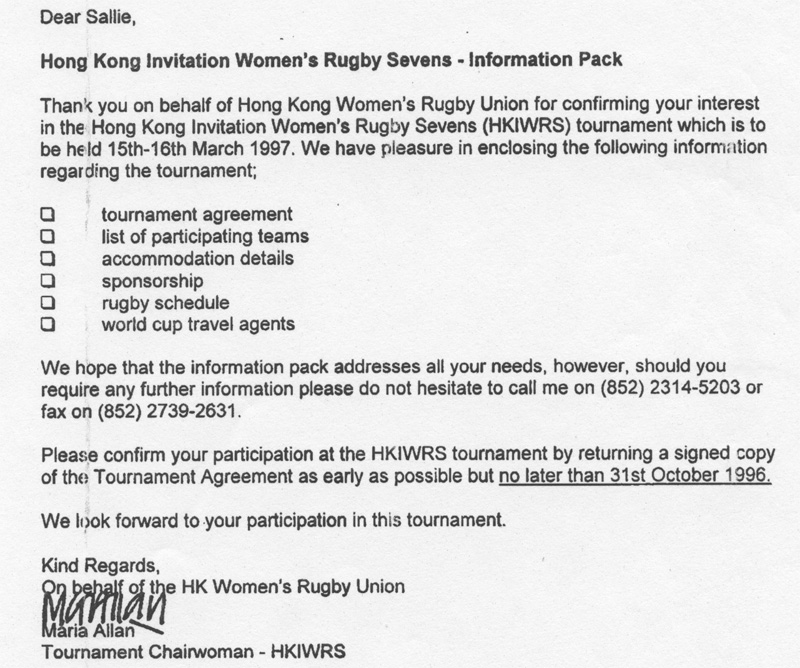
We now [I wrote in 1996] have put in place a program
to select a national team, and are moving full speed
ahead.
The next step in
providing international women's sevens venues happened
so much by accident that it still cracks me up to
think about it. I found out exactly when it
happened only in late June, when I read a May 1, 1996
article in the Eastern Express, a Hong Kong
newspaper. It quoted Hong Kong's Maria Allen,
who said, "The United States team were in Dubai and
were asking about an international fixture . . . and
it was probably from that we thought we could maybe
have our own tournament."
Well, that "United
States team ... were asking" would be me ... and this
is how it happened. The US representative at the
men’s Dubai Sevens in November 1995 was the
invitational side Atlantis which I was coaching.
We had to be at the airport at 6am on the day
following the tournament, and were a bit the worse for
wear. Next to us on the check-in lines were the
Hong Kong Police women, who had won the women's
bracket of the Dubai Sevens. They were in no
better shape than we, maybe worse.
Having listened to USA
women’s sevens coordinator Sallie Ahlert badger me for
three years about finding a venue for US women All
Stars to play, and having been seven times, as either
coach or manager to the men Eagles, to the Hong Kong
Sevens, where good sevens play is venerated, I put two
and two together and realized that these Hong Kong
women rugby players might represent an opportunity to
expand the Hong Kong Sevens to women's teams.
I remember speaking to
women's sevens chairperson Anne Marie O'Donoghue at
the airport. I inquired about the possibility of the
Hong Kong women driving an effort to use the success
of the men’s Hong Kong Sevens to provide a venue for
international women's sevens play (I was actually
trying to lead them to find an arrangement where the
US women could be involved in some kind of
mini-tournament within "the" Hong Kong Sevens).
I was amused to discover, via the Hong Kong press, that that
was almost certainly the conversation that finally got
the ball rolling.
A funny
thing, coincidence.
Anne Marie O'Donoghue left
Hong Kong not long after that meeting. Although
hers was the only name I recorded, it
turned out that the
other Hong Kong woman with
whom I spoke in that informal airport encounter
was Ruth Mitchell. Ruth was one of Hong
Kong's top players and also one of the
leaders of the Hong Kong women's rugby
community. Ruth remembers that conversation
very well.
I remember in that conversation that Anne
Marie expressed concern that the local women had been given a
little time for demo games on Sunday morning and she didn't want
to lose that; also she didn't know that they were ready for such
a grandiose scheme. So we started with an invitational
tournament that took place the day before the men's
tournament. There were only 4 teams scheduled to take
part, and the Atlantis women were one of them. In the end,
there was a monster rain storm the night before the tournament
and it was moved from a legitimate venue (Aberdeen Stadium) to
an elementary school field with barely room for a sideline, and
delayed by a couple of hours. We won the tournament
easily, but it would have died there, I think, except for one
small fact: BBC commentator Ian Robertson was there. More
on this below.
Two articles from the Hong
Kong paper, one from April 30 and the referenced one from May 1
are inserted below.
Article from April 30 Hong Kong Eastern Express:
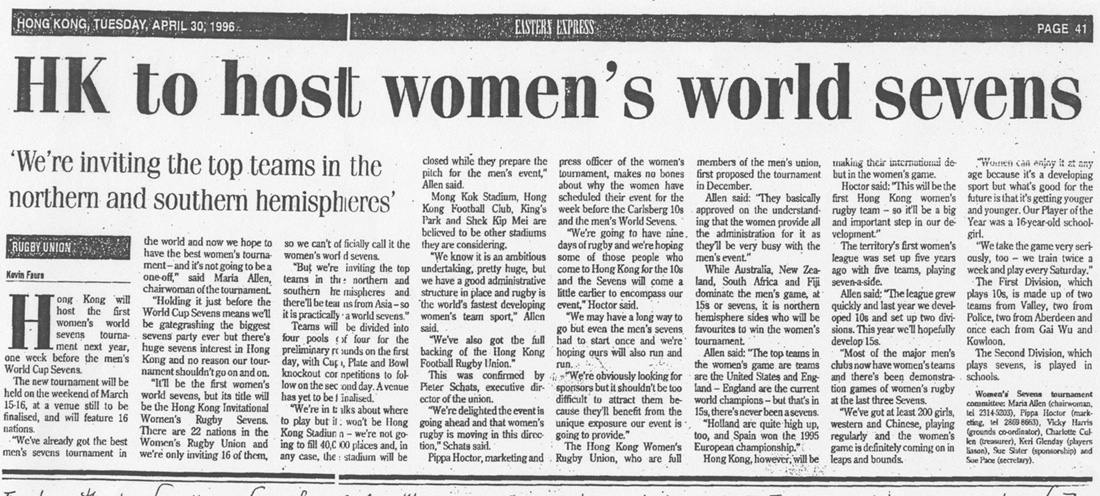
This article provided the
good news, but it was the next day's article that gave some
insights as to how they had decided to hold it. From the
May 1, 1996 Eastern Express:
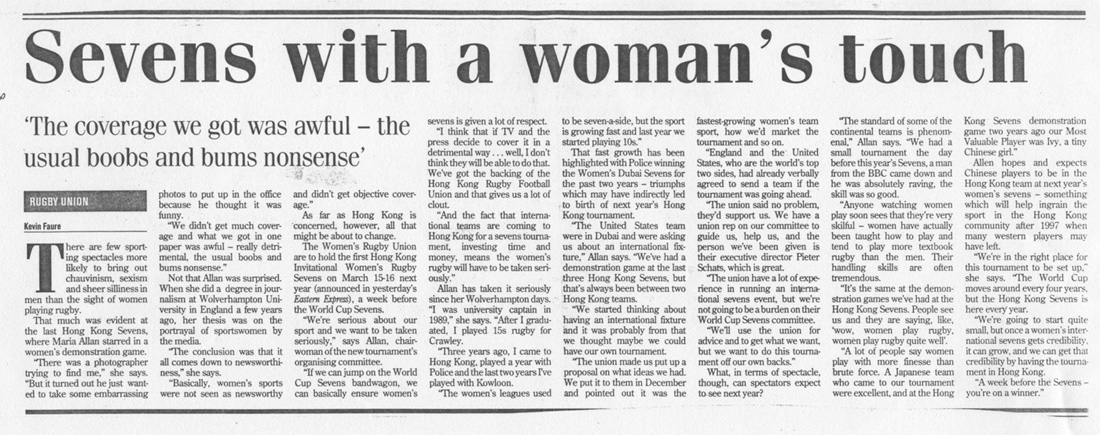
There are a few key points in this article,
which highlights a decision - to host international women's sevens - that will
result in new-found respect for women's rugby in Hong
Kong. Maria Allan comments: "all that [boobs and
bums nonsense] might be about to change." In column 5 she
references the
meeting in Dubai mentioned in Alex's
article; she also references, in the 7th
column (second column from the right), "we had a small
tournament the day before this year's Sevens, a man from the BBC
came down and he was absolutely raving, the skill level was so
good."
Well, as noted, that man was Ian Robertson
from the BBC, a long-time commentator on the Hong Kong Sevens
(and a former Scottish
international and British
Lion). I knew Ian from the years I
coached and managed the US men's
national team at the Hong Kong Sevens - he used to come to our
practices to familiarize himself with the players. The
team he was raving about was Atlantis (by the end of the day,
we had emptied our bag of tricks, and they had all
worked).
Note that there were a few
things that still concerned the HK women. In the April 30 piece
above, Maria Allan notes that the 1997 tournament will take
place the week before the men's sevens, and "it won't be in Hong
Kong Stadium - we're not going to fill 40,000 places and, in any
case, the stadium will be closed while they prepare for the
men's event." I'll discuss later in the piece how, despite
these comments, the final ended up in the stadium in 1999.
Our 1996 team? Well this was
just a club tournament, and we played as the invitational rugby
club Atlantis. Our team, however, comprised mostly international
players; our goal was to impress. Here is a team picture:
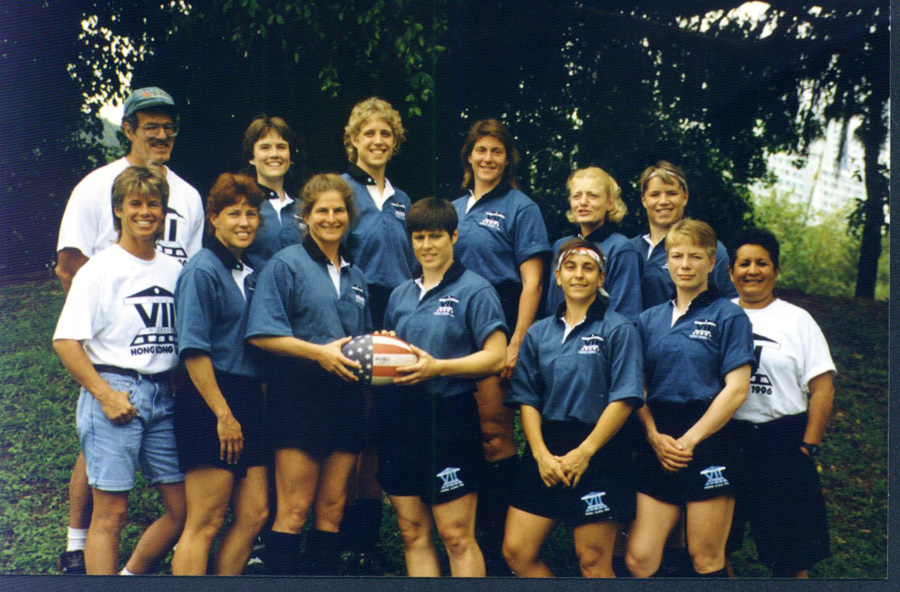
Atlantis
Women, Hong Kong Women's Rugby Club Tournament, March 1996
Top, L to R: Emil Signes, Pam Irby, Nancy Fitz, MJ Mohl,
Sallie Ahlert, Amy Westerman
Bottom, L to R: Janet Marshall, Tracy Moens, Candi Orsini,
Patty Jervey, Kim Cyganik, Jos Bergmann, Suzanne Cobarruvias
Before going on, I'd like to
back up to 1988, because that's where the story takes wings. The
first-ever Hong Kong [men's] Sevens took place in 1976, the US
was first-invited in 1981, and it soon became apparent that we
could compete against anyone in this game. I was named
coach in 1986 and in 1988, when I was also a member of USARFU's
Board of Directors, I was asked to chair a National Sevens
Committee to spread the game of sevens throughout the US. One of
the first things I did was to encourage all groups other than
just senior men (there had been both a club and All-Star Sevens
for the men since 1985) - i.e. senior women, collegiate,
military, youth, etc. of both sexes - to organize their own
sevens structure.
Donna Hylton of NOVA agreed to chair the women's effort, and
although unsuccessful in generating immediate national interest,
she did manage to establish a qualifying process and a club
championship in the East, beginning in Norfolk in 1991.
In
1992, while I was assistant national coach to the US women’s
15s team, I helped Tara Flanagan organize the first-ever
women’s Atlantis team, which participated in - and won
- Spain’s prestigious Benidorm Sevens. We
fielded mostly Eagles, and in the Benidorm final beat a
Saracens (London) team that started 6 England
internationals.
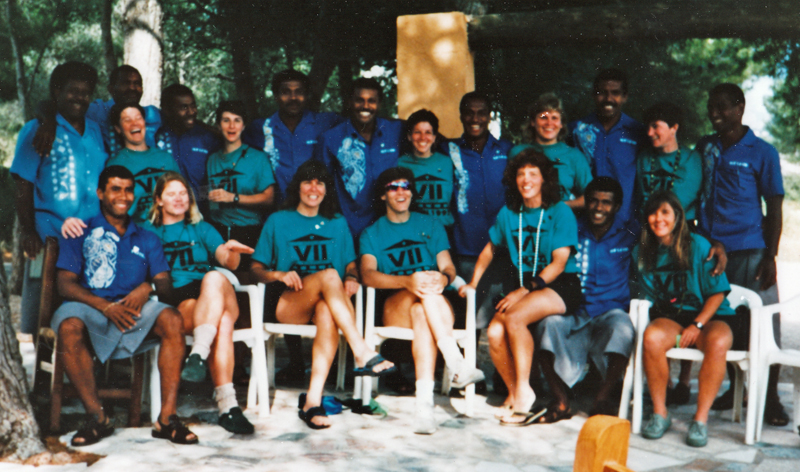
May 1992: Atlantis
Women and Fiji men, Benidorm tournament champions
Atlantis, standing: Chris Harju, Kathy Brown, Mary Beth
Spirk, Julie Drustrup, Krista McFarren
Atlantis, seated: Sheri Hunt, Tam Breckenridge, Tara
Flanagan, Tracy Henderson (Moens), Elise Huffer
Note Waisale Serevi, seated left
The report of this tour got Oklahoma’s Sallie Ahlert excited about the prospect of All-Star Sevens teams. When I told her I thought select-sides were pointless unless they had something to do, somewhere to go, she initiated a formal process to select an official West Women’s Sevens side that not only existed in name, but also traveled -- to Cape Fear in 1994 (finalists), Toronto in 1995 (finalists), and Las Vegas 1996 (champions).
Sallie even organized an unofficial
national women’s club sevens competition in 1993 won by
Southeast of Atlanta. (These unofficial championships continued
for years until the first-ever official USA Rugby
women's club sevens competition in 2011, won by the Berkeley All
Blues. Women's All-Star Sevens began in 2001, when they were
known as ITTs [Inter-territorial tournaments].)
Still, there was no place for a national women's team to go,
which takes us back to my earlier comments about Sallie
badgering me to find one. In retrospect, her pestering me
was certainly on my mind when I approached the Hong Kong women
at the Dubai airport in 1995 to urge them to start a Hong Kong
Women's Sevens. (I use the words "badgering" and "pestering" because that's the
way I saw it at the time; in the end she just did what she
needed to do to get me to act; I am certainly
grateful for her persistence.)
1997-1999:
A Start, a Hiccup, and a Leap
[1997]: The First
International Women’s Sevens:
After a competitive first 10 minutes, in which New
Zealand scored only on the first and last play, and a strong
beginning to the second half, the US finally caved in to
superior athleticism and the final score was not
close. New Zealand averaged 2 points per minute or
more in all its games, and they were worthy champions.
Equally, we were clearly the second best team in the
tournament, and our semifinal win over England was very
exciting.
Twelve teams participated
in the tournament. New Zealand and the USA were 5-0 in their
pools. England and Hong Kong 2nd at 4-1.
Dianne Apiti [later Kahura] scored
4 tries for New Zealand in the final and New Zealand were
champions.
International
Women’s Sevens at “the” Sevens.
When
speaking with the Hong Kong women in 1995, I
had hoped to get a women’s event associated
with "the" Sevens. In a 1996 repeat of
that request, the word was that the women’s
time slot at the Sevens was for "Hong Kong
women." While I was resigned to that
fact this year, assistant
coach and manager Al Caravelli was not, and he
and New Zealand coach Darryl Suasua convinced
those in charge that the Hong Kong Sevens
represented a chance to market women’s rugby to
the masses, and that it was in everyone’s best
interest to put on an event showcasing the best
that we could offer.
Most players had
gone home [to
repeat, this was a full week after the women's
tourney], but there
were quite a few good players remaining for the
Sevens, and we put together a team of four New
Zealanders (Anna Richards, Anna Rush, Maata
Young and Monique Hiroranaa), three Americans (Anita
Pease, Krista McFarren and Tracy Moens), one
Australian (Libby Andrews), and Ruth Mitchell
and Charlotte Cullen of Hong Kong to play in a
“Hong Kong Women vs. the Rest of the World.”
The
game was played at 9 AM Saturday, two hours
before the first men’s match, but because of the
queuing for seats, there were probably between
5,000 and 10,000 people already in the
stands. The Rest of the World won handily,
but that wasn’t the point: the way had been
paved for future, bigger and better, women’s
participation in the Hong Kong Sevens.
Still, this
little made-up game was far from what we were
looking for.
Post-script on this
article: In this article I referenced a person I
had convinced to help me with the program, Al
Caravelli. Al came as assistant coach and
manager and ended up helping me with all the
programs with which I was associated, just as I
now help him with the US men.
“Al,”
I wrote, “brings a wealth of experience,
intelligence, intensity, compassion and puts
everything he has into every venture he undertakes.
He was a vital cog in getting women’s rugby on the
Hong Kong stadium turf in 1997.”
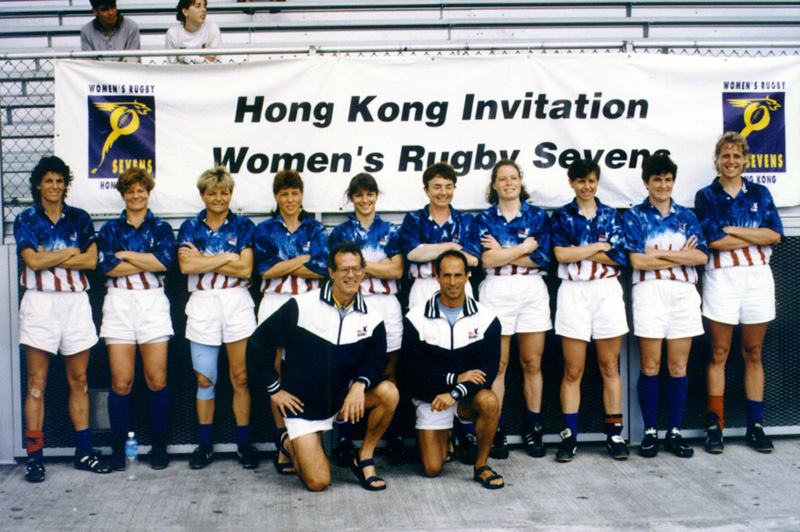
First-ever USA Women's National Sevens
Team
Standing: Anita Pease, Sheri Hunt, Janine Cochran, Tracy
Moens, Lisa Rowe, Sue Parker, Keirsten Lawton, Jen
Lucas, Krista McFarren, Nancy Fitz
Kneeling: Emil Signes, Al Caravelli
The
Women’s World Cup of 1998 dropped the number of teams
available for an international sevens event in Hong Kong and
to the great sadness of Signes and the USA team, the women's
event was canceled.
This was quite a painful time. I knew the
Women's World Cup (15s) was taking place in 1998 and I was
worried that, given the importance of the World Cup and the
novelty of the sevens, the sevens would be canceled.
We had a selection camp scheduled and I didn't want to
select a team that had nowhere to go.
But the Hong Kong Women assured me the tournament would go
on. Here's an email I received from Hong Kong on the
27th of January.
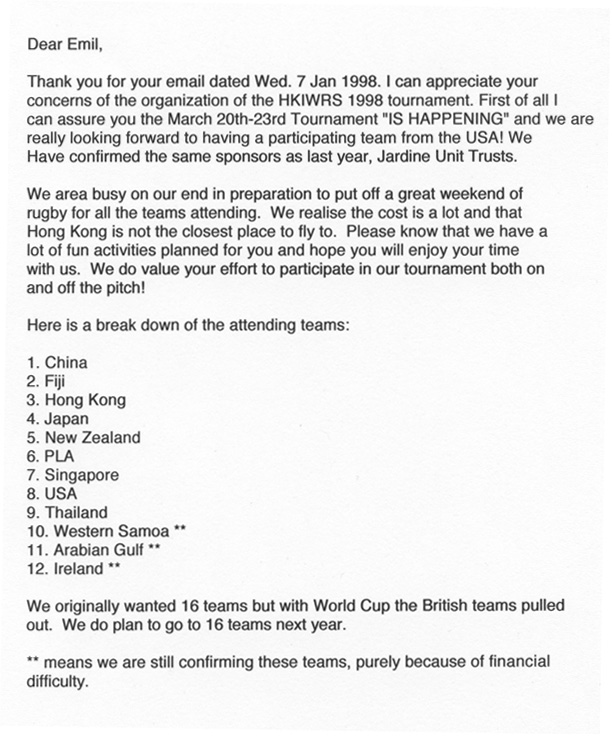
Email from Hong Kong Women telling us 1998
tournament "IS HAPPENING"
Unfortunately, the tournament did not
happen, something we did not know until after we had had our camp - which players attended on their
own funds and into which they poured their hearts and souls - and picked our team. What
this meant was that we had picked a national team with nowhere
to go.
The fact that we, along with the Hong Kong tournament, were
ground-breakers for international women's sevens meant that,
with Hong Kong out of it, we really had no other suitable
place to go. In the end we took the team to the Ontario
Sevens in Toronto, an excellent and well-attended sevens
tournament for both sexes. We won the tournament, but it was a
disappointing turn of events.
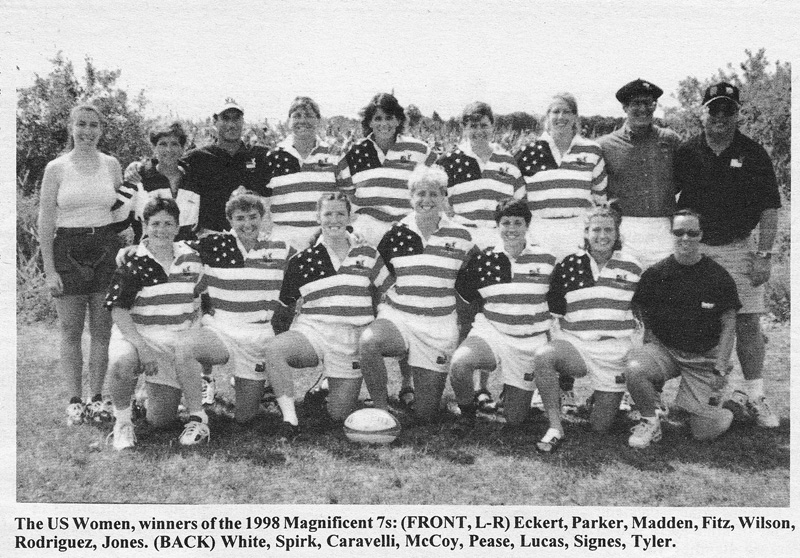
Following the 1999 event, in which we did just that,
I was touched when Dick Airth specifically credited that
conversation as the catalyst for the integration of the
women’s final with the men’s tournament. [Dick mentioned this in a talk that he gave at
the banquet following the women's tournament.]
A summary of what I wrote at the time follows.
1999. USA Sevens Women
Make the Big Time
Hong Kong, Friday, March 26, 1999. Playing
in Hong Kong stadium during “the” Sevens in front of
more than 20,000 people should be every ambitious rugby
player’s dream. Very few, however, achieve this
dream. Particularly women. That’s because,
until now, there has never been a significant women’s
game played at this venue.
1999, the 24th year of the Hong Kong Sevens,
was the first year that an important women’s match was
contested in the hallowed ground of the Hong Kong
Stadium.
Our primary goal was to get to that
final. And, with a convincing victory over a
strong England team in the semifinals, we did it!
That semifinal, incidentally, may well have been the
first international rugby game in which identical
twins – Jane and Emma Mitchell – competed against
each other (Jane for the US and Emma for England).
In the finals, the US
women gave New Zealand everything they could handle
in the first half, holding them scoreless for the
first seven minutes, and trailing only 0-5 at half
time of the 20-minute game. The US, in fact,
was within 10 meters of the NZ goal for an extended
period, and in the end it was our offense and not
our D, that was to let us down.
On the sidelines as
US team mascot was 6-year-old Kristina Caravelli.
The fans raved about
the game, and our players were recognized, and
complimented, by dozens of fans as they left the
stadium at the end of the evening.
Furthermore, during the course of the next two days,
several coaches, players, committee members and
members of the media spoke to me with great
admiration for the standard of play. Even
commentator David Campese, who two years earlier had
said women shouldn’t be playing rugby, spoke
positively of the game, and talking with him made it
obvious he had watched the whole thing.
A quick aside to elaborate on the David Campese
comment: "Campo" was a legendary Australian winger in
the 80s and early 90s; I knew him from our paths crossing
many times; not only were we at the same events, but the US
7s team scrimmaged Australia on many occasions. When I
told him I was coaching the US women, he grumbled something
about the unsuitability of women playing rugby (Campo is
nothing if not opinionated). This particular evening,
though, we met back at the hotel, and he was describing some
of the play in that game in great detail and in a very
complimentary fashion; as I noted above, it
made me realize that he'd not only watched it but
paid a lot of attention to it. Funny guy, Campo.
Playing in the Hong Kong stadium in front of a huge crowd -
and playing so well (both teams) - was super-important for
women's rugby in general, and for the US women in particular
(from our perspective, of course). Our credibility was
at stake. The preliminary games were played just down the
road at the Hong Kong Football Club and we had to beat
England to get into the stadium. It was a phenomenal win -
and with two identical twins playing against each other,
there was a little additional drama as well.
Here's the US squad. This picture was taken
following the final against New Zealand. The US lost
the game, but the game won the future for women's sevens.
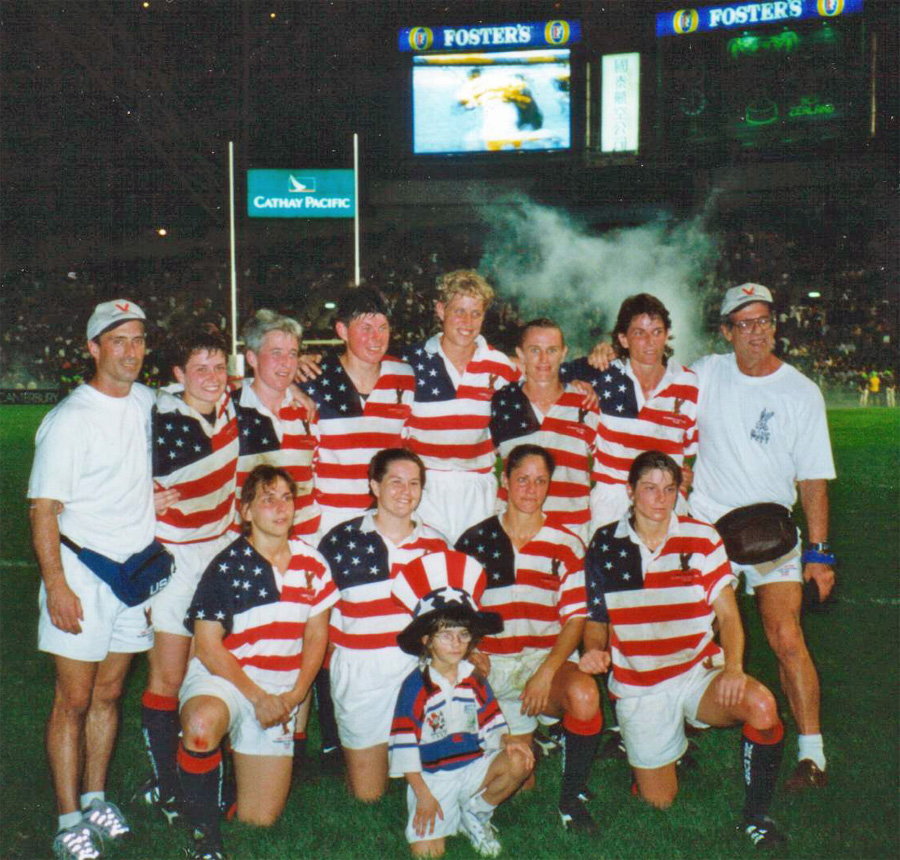
US Women after Final -in
"the" Hong Kong Stadium-, Hong Kong Women's Sevens
1999
Standing: Al Caravelli, Inés Rodríguez, Jane Mitchell,
Erina Queen, Nancy Fitz, Diane Schnapp, Anita Pease,
Emil Signes
Kneeling, players: Kim Cyganik, Michele Friel, Laura
Cabrera, Lisa Rowe
Kneeling, mascot: Kristina Caravelli
New Zealand won the next 3 years, and in 2002 the IRB’s Jamie Scott attended the women’s banquet and outlined a plan that saw the women's World Cup 7s in 2005. Scott turned out to be 4-years premature, but, said Signes, "the handwriting never left the wall."
The following, from the
Hong Kong Women's Sevens Program, was written by Jamie
Scott, IRB Executive Council Representative, Asia. Jamie
presented its contents to the women at our banquet
following the tournament. It was exciting.
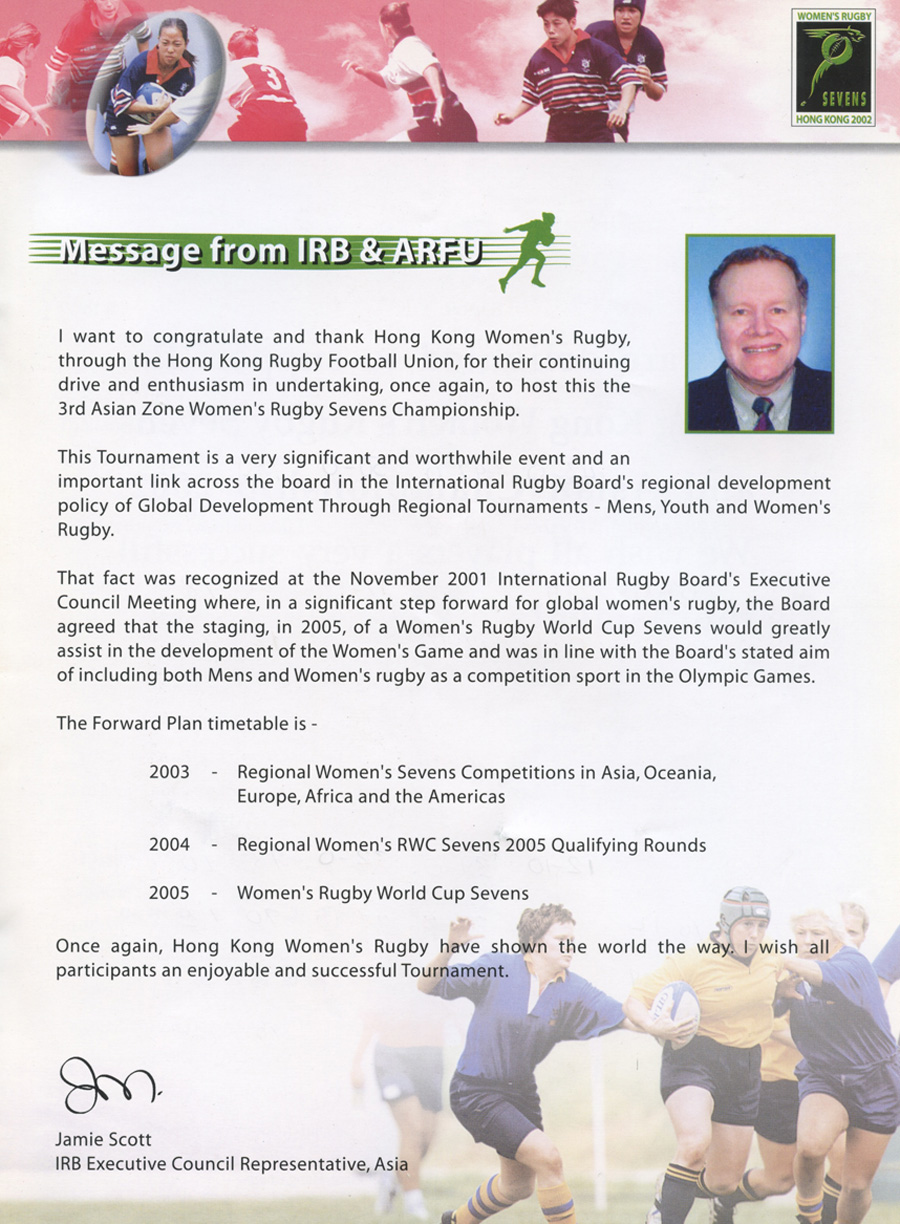
After that, the work kept
getting done. Dubai held their tournament. The women's
tournament in Hong Kong continued to grow, and when the USA 7s
was started in 2004, there was always a women's presence. The
USA didn't always win at the USA 7s, but they kept
putting their handwriting on that wall, bringing in Canada,
China, South Africa, England, and the New Zealand
Maori.
Following Hong Kong, other
nations started to host women's sevens tournaments.
New Zealand hosted an international tournament in Wellington
in 2001 and in Whangarei from 2001 to 2003; Japan held an
international women's tournament in 2001 in Yokohama, and
Fiji in 2003 in Suva. The US attended all of them.
Regional tournaments for national women's teams - in Europe,
Asia, Africa, North America/Caribbean, and South America -
began in the early 2000s and exploded with the 2006
announcement of a men AND women's Rugby World Cup Sevens in
2009, after rugby's 2005 bid for Olympic inclusion was
turned down for lack of a suitable women's presence.
At the 2009 USA 7s the USA
v. England game ended in a tie. The men's tournament
schedule was almost sacrosanct and there was no time to play
overtime. IRB Chairman Bernard Lapasset didn't hesitate.
"Play overtime" he said. So they did. Women's 7s had to have
enough meaning to crown a champion.
Signes:
The rest, as they say, is history. I left the
women’s sevens position in 2005 (I had hoped to hang on
till the first World Cup but 9 years was enough) and I’m
now [2008] back
with the US men’s coaching staff as video analyst.
Nevertheless the US, and now the world’s, commitment to
international women’s sevens goes on. The World Cup Sevens
for women was not held in 2005, but it will go on in March
of 2009 in Dubai in conjunction with the men’s Rugby World
Cup Sevens at the same event. The dream of the US women’s
rugby community 20 years ago, my dream, Emilito’s dream,
will culminate in reality … it should be a great event!
And I am thrilled to have sowed the seed that
reaped such a bountiful harvest.
I have spent my
entire rugby career trying to get the men and women
of rugby to appreciate each other; hopefully this
event takes us along the desired path.
Afterwords
While
I’ve described a process in more or less chronological order,
lots of things were happening in the background, some of which
may be relevant to the final outcome, some of which are merely
(but possibly interesting) footnotes. The first one discusses creating an
ambiance for the integration of men and women’s teams. The second presents
articles representing 25 years of speculation about rugby in the
Olympics and a quick note on one of my earliest experiences
coaching women’s sevens, followed by a very quick synopsis of
the progression from teams like that to the Olympic games (my version,
anyway).
1. Boys
and Girls Together
To my mind
the 2009 Dubai Sevens World Cup, with men and women’s games
alternating on two fields (the main field in the stadium and a
field behind the stadium with a nice hillside from which to
watch) throughout the weekend – and 54,000 fans in the stadium
- represented an event I’d been dreaming about for more than
20 years. There
have been men and women’s brackets at US sevens tournaments
almost as long as there’s been women’s rugby in the US: the
first such tournament I attended was the New York
Sevens in 1975. The
first time I was associated with sevens teams of both genders
was our local Bethlehem tournament, in which I coached both
the Bethlehem men and women's sevens (the Hooligans and Maulie
Maguires) starting in 1982. We
spent a lot of time training together, playing touch together,
and it worked out better than one might have thought.
At the elite
level, the first event I recall in which I was affiliated with
sevens teams of both genders was the 1992 Benidorm Sevens. I attended in two
functions: as manager of the US men’s team – who competed in
the men’s international bracket - and coach of the women’s
Atlantis team – in the women’s bracket. As at most of these
events, at the start each was wary of the other, but by the
end of the week the players were best friends. Based on
Facebook comments, they continue to look at that week as a
great event for both rugby and social interaction. The men got
to the semifinals, losing to champion Fiji, and the women won
the tournament over a Saracens team of mostly England
internationals.
Ironically,
when they returned to JFK airport they received news of two
not-so-friendly dual-gender national 15s tournaments (men’s
All-Star and women’s clubs) held at the same venue in MN. (From what I heard, "not so
friendly" was putting it mildly.) In
contrast this sevens tour in particular – and sevens
in general - proved to be a great way for players of both
genders to interact positively off the field as well as being
fans for one another on the field.
In 1998 the
situation was reversed.
The US women’s national sevens team participated in the
Ontario Sevens; I coached this team and Mary Beth Spirk coached the Atlantis
Collegiate men (Mary Beth, incidentally, is now
among the nation’s top 20 all-time
winningest coaches in women’s NCAA D-3 basketball [at
Moravian College]). The two sexes got along
fine, the women – one of whom was future national sevens coach
Jules McCoy – acting
as solicitous big sisters to the college boys.
Starting in
the late 90s, there have also been a dozen joint men and women
Atlantis tours: 7 to the Caribbean Sevens in Port of Spain,
Trinidad (what a great venue!), 3 at Cape Fear, one to Brazil
(a tour for the ages), one to Mexico, and most recently one to
Cuba in 2011.
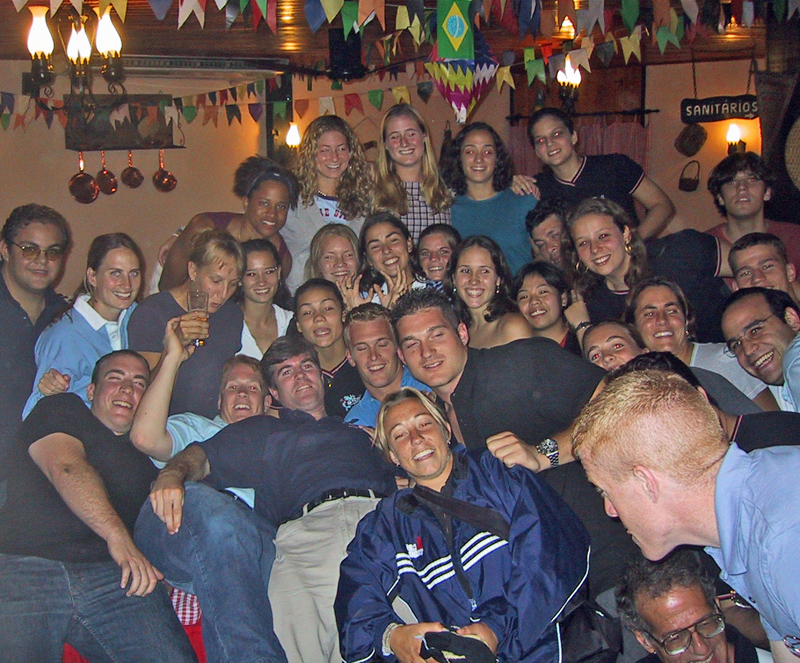
For many years both the men’s collegiate All-Stars
and the women’s U-23 team competed in the All-Star Sevens.
On a couple of occasions we got together for a joint
barbecue before the event.
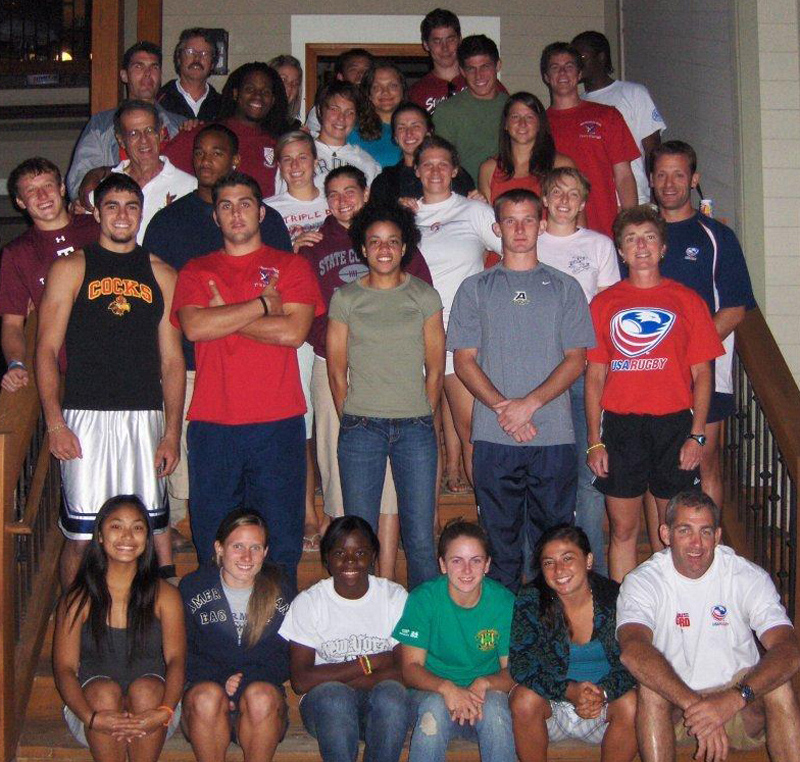
On one
occasion – the 2011 CRC Sevens in Philadelphia – I was both
coaching the Princeton women and helping to coach the Arizona
men. We got together for a dinner prior
to the tournament, at which a brief exchange took place that
has made it into U of Arizona rugby lore: one of the Arizona
players, making conversation, asked the Princeton co-captain
who their biggest rival was.
She paused for a moment and said, “You mean
academically?”
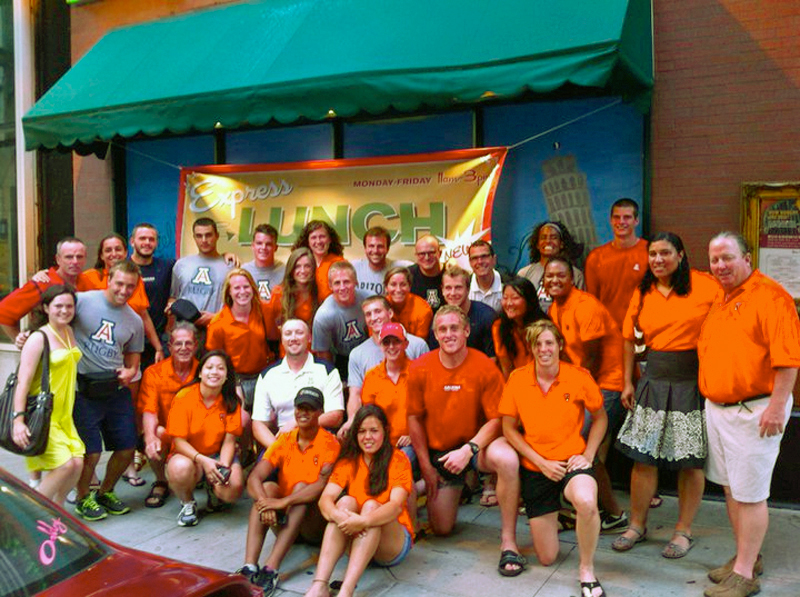
At any rate,
to get beyond these anecdotes, the Rugby World Cup Sevens of
2009 in Dubai has shown how successful these joint tournaments
can be. 54,000
fans throughout the weekend loved every game, both men and
women’s.
At one
point, I’m told, NBC, who televises the CRC Sevens, haughtily
dismissed any notion of televising any of the women’s games at
the event: “Do they televise the NBA and WNBA games together?”
was one of the ridiculous comments they apparently made. Well, no, but those
games aren’t less than 20 minutes long nor played in strings
of several unrelated games at a time in packed stadiums. Most
major sports have events that are 2 hours long, or longer. In sevens rugby we
can fit 6 games into a 2 hour time period; why not mix men and
women’s games?
I could be wrong. But my heart
tells me I'm right.
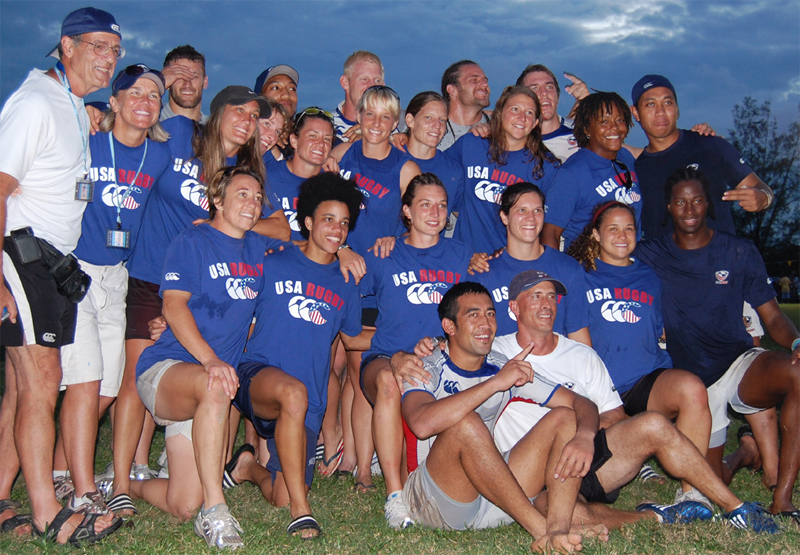
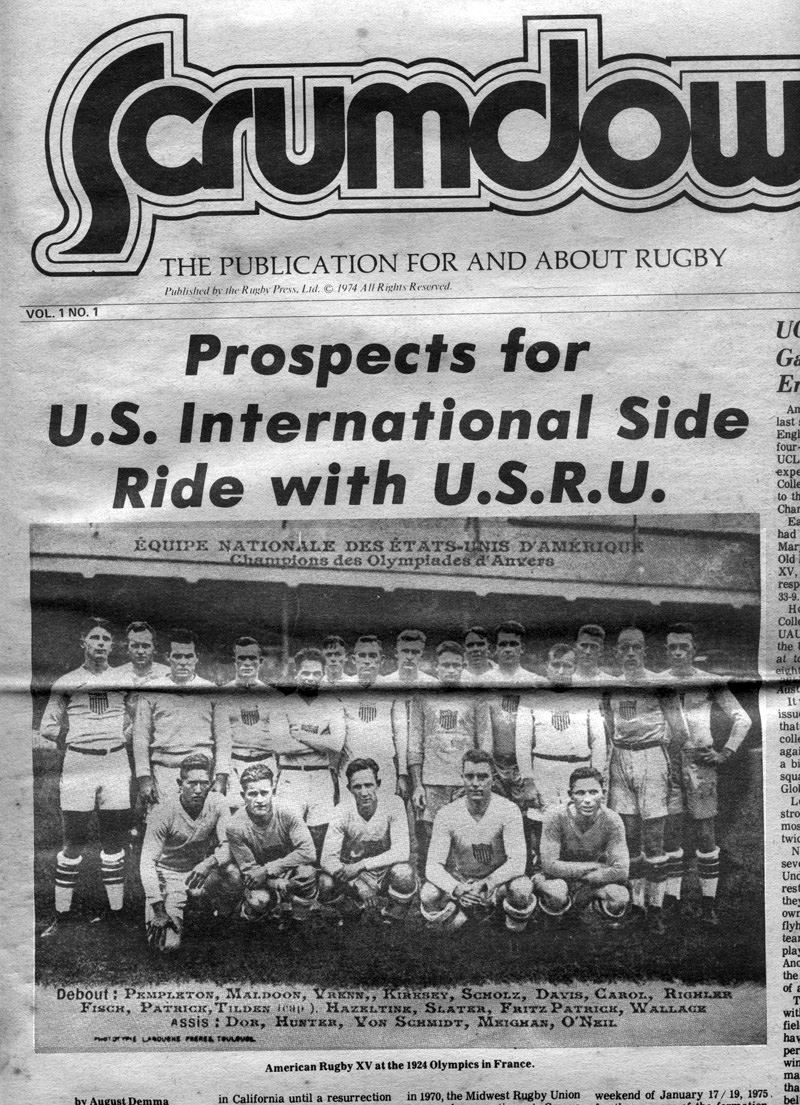
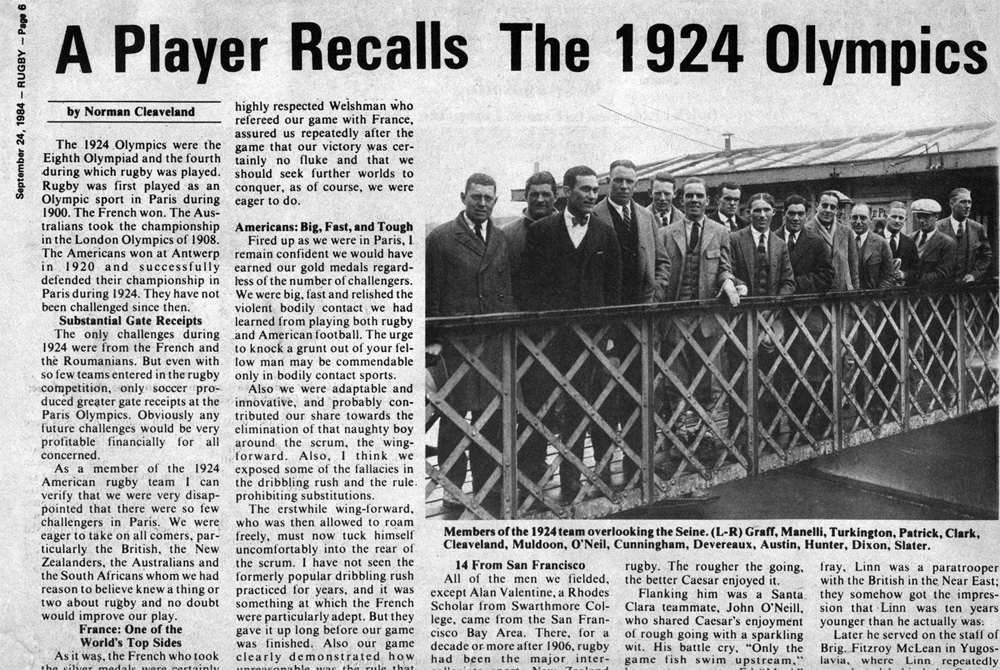
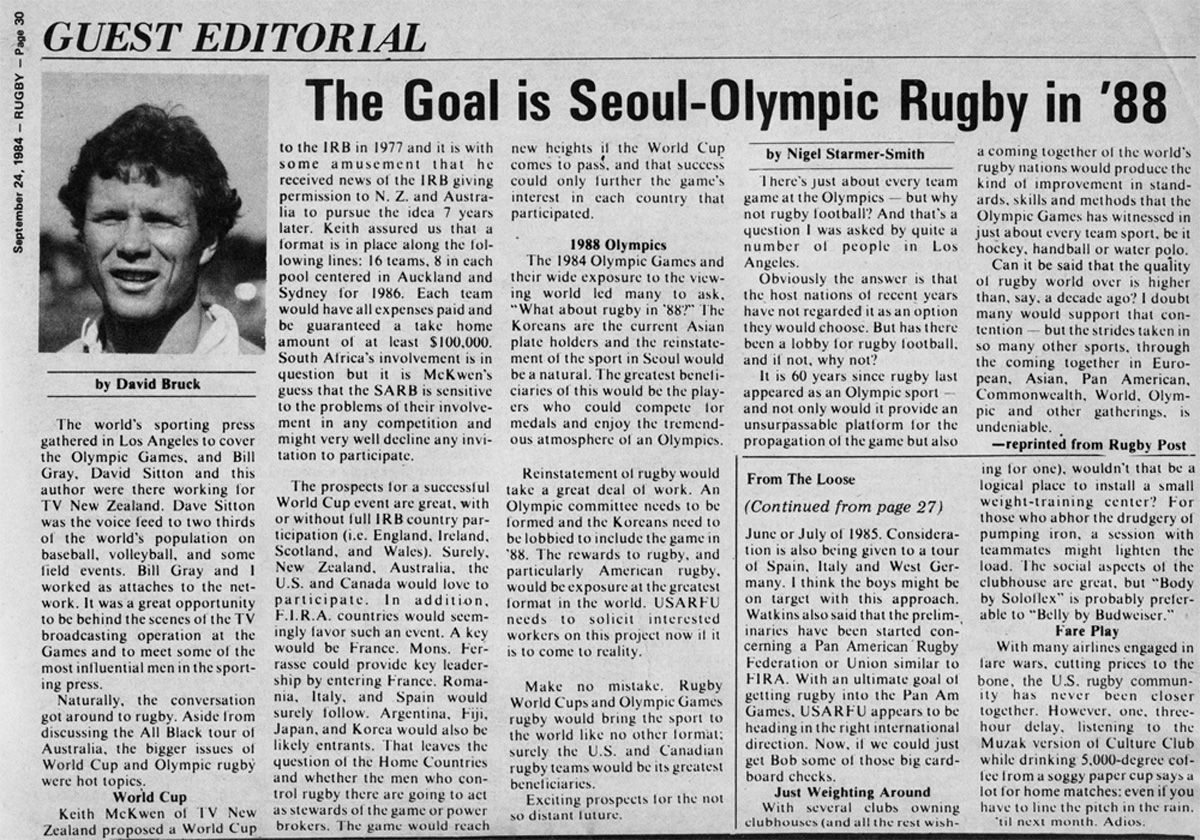
1984 articles by
David Bruck and Nigel Starmer-Smith.
Bruck, noting that a Rugby World Cup was about to announced
for 1987, says, regarding the Olympics, "What about rugby in
'88?"
Starmer-Smith notes that Olympic participation makes sports
stronger.
The next article I found in Rugby
was an editorial by Ed Hagerty in the July 1994 issue and
was titled "Sevens Rugby in the 2000 Olympics?" Obviously
it didn't happen; there was an interesting comment in this
article, however: IRB Secretary Keith Rowlands was interested
in recognition but not Olympic participation.
Why? England and Wales and Scotland wouldn't be allowed to play.
Sigh.
This was the first time that I had seen sevens
mentioned in print as a potential Olympic sport, and I
salivated.
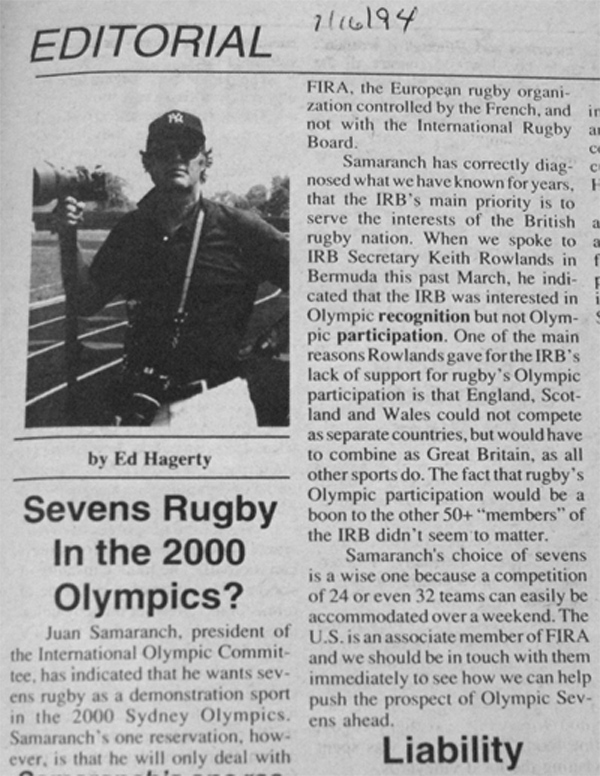
In December
1994, Juan Antonio Samaranch announced that rugby was back
as an Olympic sport, but it would have to wait 10 years to
appear. (That would have made it 2004.)
